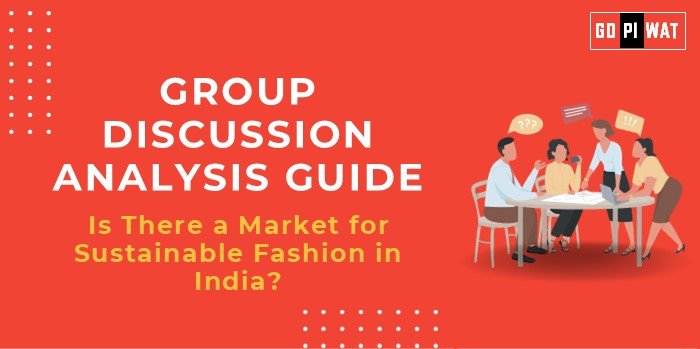📋 Group Discussion (GD) Analysis Guide: Is There a Market for Sustainable Fashion in India?
🌐 Introduction to Sustainable Fashion
- 📜 Opening Context: The global fashion industry, valued at $1.7 trillion, is under scrutiny for its environmental impact. With increasing awareness of sustainability, India—a $70 billion apparel market—stands at the crossroads of adopting sustainable fashion.
- 📖 Topic Background: The push for sustainability in fashion stems from concerns about fast fashion’s environmental and social costs, including carbon emissions and unethical labor practices. Recent trends, like circular fashion and upcycling, are gaining momentum in India, driven by urban consumers.
📊 Quick Facts and Key Statistics
- 👕 Textile Industry Contribution: Accounts for 2% of global GDP, with India as the second-largest textile producer globally.
- 🌍 Environmental Impact: Fashion accounts for 10% of global carbon emissions, with dyeing and finishing responsible for 20% of industrial water pollution.
- 💡 Consumer Sentiment in India: 61% of urban millennials prefer sustainable brands (BCG report, 2023).
- 📈 Market Growth: Indian sustainable fashion market expected to grow at 10% CAGR, reaching $15 billion by 2030.
- 🗑️ Textile Waste: India generates over 1 million tonnes annually, 60% of which ends up in landfills.
👥 Stakeholders and Their Roles
- 🏛️ Government: Promotes sustainable practices through schemes like PLI (Production-Linked Incentive) for textiles.
- 💼 Private Sector: Brands like FabIndia and Doodlage emphasize eco-friendly materials and practices.
- 👗 Consumers: Rising demand for ethical and green fashion among urban youth.
- 🌍 International Organizations: UN and GOTS (Global Organic Textile Standard) advocate for sustainable certifications.
- 🌱 NGOs: Aid in awareness and waste management campaigns.
🏆 Achievements and Challenges
✨ Achievements
- 🎨 Brand Innovation: Indian brands are incorporating organic fabrics and biodegradable dyes, aligning with global trends.
- 📢 Consumer Awareness: Events like Lakme Fashion Week’s sustainability-focused segments bring attention to green initiatives.
- 🏛️ Government Initiatives: Policies like the National Textile Policy (2022) incentivize sustainable practices.
⚠️ Challenges
- 💸 High Costs: Sustainable materials increase product prices by 20-30%.
- 📉 Limited Awareness: 70% of rural consumers remain unaware of sustainable options.
- 🔗 Supply Chain Issues: Ethical sourcing and traceability remain inconsistent.
Global Comparisons:
• Success: Nordic countries lead with brands like H&M Conscious and Pangaia.
• Challenges: Countries like Bangladesh face hurdles in scaling sustainable production despite low costs.
Case Studies:
• Kerala’s Khadi Revival: Focused on organic, handmade textiles.
• Rajasthan’s Block Printing: Emphasizes traditional methods using eco-friendly materials.
📢 Structured Arguments for Discussion
- 💬 Supporting Stance: “Sustainable fashion is the future, with urban Indian consumers embracing eco-conscious lifestyles.”
- 🗣️ Opposing Stance: “The lack of affordability and awareness limits sustainable fashion to niche markets.”
- ⚖️ Balanced Perspective: “While urban demand is growing, scaling affordability and rural adoption is critical for sustainable fashion to thrive.”
📈 Effective Discussion Approaches
- 💡 Opening Approaches:
- Start with data: “Sustainable fashion in India is expected to grow at 10% CAGR by 2030…”
- Use contrast: “While urban India embraces green fashion, rural regions lag behind in awareness.”
- 💡 Counter-Argument Handling:
- Address cost concerns by citing examples of affordable sustainable brands.
- Counter “niche market” arguments by discussing urban trends and export potential.
📊 Strategic Analysis of Strengths and Weaknesses
Strengths
- 👗 Growing urban demand.
- 🏛️ Government support.
- 👩🔧 Skilled labor in textiles and traditional crafts.
Weaknesses
- 💸 High production costs.
- 🔗 Fragmented supply chains.
- 📉 Lack of awareness in rural areas.
Opportunities
- 🌐 Export potential to sustainability-focused global markets.
- 🔬 Innovation in affordable eco-friendly textiles.
Threats
- 🌍 Competition from global brands.
- ⚠️ Greenwashing concerns undermining consumer trust.
🎓 Connecting with B-School Applications
- 💡 Real-World Applications:
- Discuss business models focused on sustainability, e.g., green supply chains in operations or sustainable brand marketing.
- 💡 Sample Interview Questions:
- “How can India balance affordability and sustainability in fashion?”
- “Discuss the role of digital marketing in promoting green brands.”
- 💡 Insights for B-School Students:
- Incorporate sustainability into market analysis projects.
- Explore ethical sourcing strategies during internships.
- Analyze the interplay between consumer behavior and eco-conscious branding.


